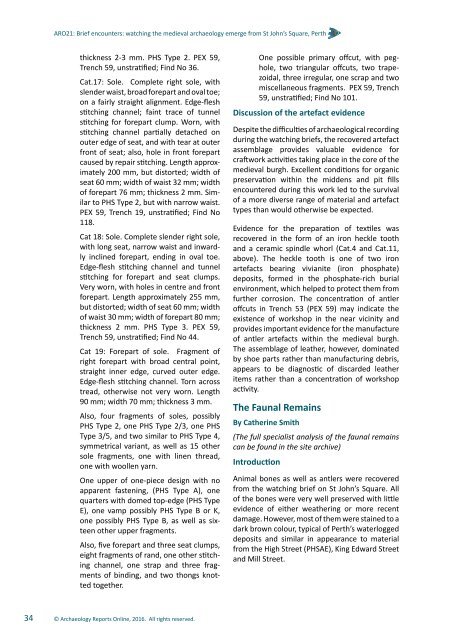medieval archaeology emerge from St John’s Square Perth
ARO21_St_Johns_Square
ARO21_St_Johns_Square
Create successful ePaper yourself
Turn your PDF publications into a flip-book with our unique Google optimized e-Paper software.
ARO21: Brief encounters: watching the <strong>medieval</strong> <strong>archaeology</strong> <strong>emerge</strong> <strong>from</strong> <strong>St</strong> <strong>John’s</strong> <strong>Square</strong>, <strong>Perth</strong><br />
thickness 2-3 mm. PHS Type 2. PEX 59,<br />
Trench 59, unstratified; Find No 36.<br />
Cat.17: Sole. Complete right sole, with<br />
slender waist, broad forepart and oval toe;<br />
on a fairly straight alignment. Edge-flesh<br />
stitching channel; faint trace of tunnel<br />
stitching for forepart clump. Worn, with<br />
stitching channel partially detached on<br />
outer edge of seat, and with tear at outer<br />
front of seat; also, hole in front forepart<br />
caused by repair stitching. Length approximately<br />
200 mm, but distorted; width of<br />
seat 60 mm; width of waist 32 mm; width<br />
of forepart 76 mm; thickness 2 mm. Similar<br />
to PHS Type 2, but with narrow waist.<br />
PEX 59, Trench 19, unstratified; Find No<br />
118.<br />
Cat 18: Sole. Complete slender right sole,<br />
with long seat, narrow waist and inwardly<br />
inclined forepart, ending in oval toe.<br />
Edge-flesh stitching channel and tunnel<br />
stitching for forepart and seat clumps.<br />
Very worn, with holes in centre and front<br />
forepart. Length approximately 255 mm,<br />
but distorted; width of seat 60 mm; width<br />
of waist 30 mm; width of forepart 80 mm;<br />
thickness 2 mm. PHS Type 3. PEX 59,<br />
Trench 59, unstratified; Find No 44.<br />
Cat 19: Forepart of sole. Fragment of<br />
right forepart with broad central point,<br />
straight inner edge, curved outer edge.<br />
Edge-flesh stitching channel. Torn across<br />
tread, otherwise not very worn. Length<br />
90 mm; width 70 mm; thickness 3 mm.<br />
Also, four fragments of soles, possibly<br />
PHS Type 2, one PHS Type 2/3, one PHS<br />
Type 3/5, and two similar to PHS Type 4,<br />
symmetrical variant, as well as 15 other<br />
sole fragments, one with linen thread,<br />
one with woollen yarn.<br />
One upper of one-piece design with no<br />
apparent fastening, (PHS Type A), one<br />
quarters with domed top-edge (PHS Type<br />
E), one vamp possibly PHS Type B or K,<br />
one possibly PHS Type B, as well as sixteen<br />
other upper fragments.<br />
Also, five forepart and three seat clumps,<br />
eight fragments of rand, one other stitching<br />
channel, one strap and three fragments<br />
of binding, and two thongs knotted<br />
together.<br />
One possible primary offcut, with peghole,<br />
two triangular offcuts, two trapezoidal,<br />
three irregular, one scrap and two<br />
miscellaneous fragments. PEX 59, Trench<br />
59, unstratified; Find No 101.<br />
Discussion of the artefact evidence<br />
Despite the difficulties of archaeological recording<br />
during the watching briefs, the recovered artefact<br />
assemblage provides valuable evidence for<br />
craftwork activities taking place in the core of the<br />
<strong>medieval</strong> burgh. Excellent conditions for organic<br />
preservation within the middens and pit fills<br />
encountered during this work led to the survival<br />
of a more diverse range of material and artefact<br />
types than would otherwise be expected.<br />
Evidence for the preparation of textiles was<br />
recovered in the form of an iron heckle tooth<br />
and a ceramic spindle whorl (Cat.4 and Cat.11,<br />
above). The heckle tooth is one of two iron<br />
artefacts bearing vivianite (iron phosphate)<br />
deposits, formed in the phosphate-rich burial<br />
environment, which helped to protect them <strong>from</strong><br />
further corrosion. The concentration of antler<br />
offcuts in Trench 53 (PEX 59) may indicate the<br />
existence of workshop in the near vicinity and<br />
provides important evidence for the manufacture<br />
of antler artefacts within the <strong>medieval</strong> burgh.<br />
The assemblage of leather, however, dominated<br />
by shoe parts rather than manufacturing debris,<br />
appears to be diagnostic of discarded leather<br />
items rather than a concentration of workshop<br />
activity.<br />
The Faunal Remains<br />
By Catherine Smith<br />
(The full specialist analysis of the faunal remains<br />
can be found in the site archive)<br />
Introduction<br />
Animal bones as well as antlers were recovered<br />
<strong>from</strong> the watching brief on <strong>St</strong> <strong>John’s</strong> <strong>Square</strong>. All<br />
of the bones were very well preserved with little<br />
evidence of either weathering or more recent<br />
damage. However, most of them were stained to a<br />
dark brown colour, typical of <strong>Perth</strong>’s waterlogged<br />
deposits and similar in appearance to material<br />
<strong>from</strong> the High <strong>St</strong>reet (PHSAE), King Edward <strong>St</strong>reet<br />
and Mill <strong>St</strong>reet.<br />
34<br />
© Archaeology Reports Online, 2016. All rights reserved.


